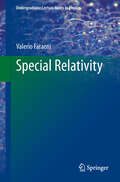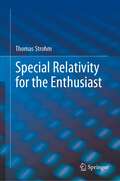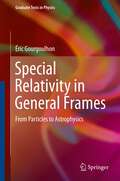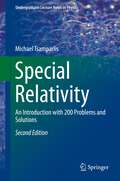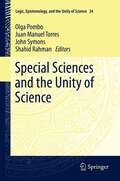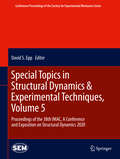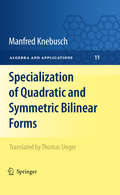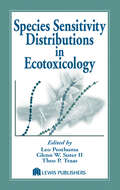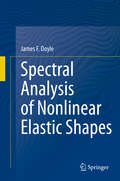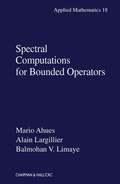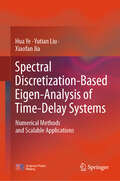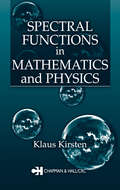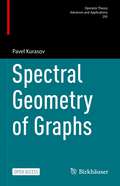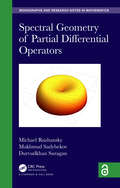- Table View
- List View
Special Matrices and Their Applications in Numerical Mathematics: Second Edition
by Miroslav FiedlerThis revised and corrected second edition of a classic book on special matrices provides researchers in numerical linear algebra and students of general computational mathematics with an essential reference.Author Miroslav Fiedler, a Professor at the Institute of Computer Science of the Academy of Sciences of the Czech Republic, Prague, begins with definitions of basic concepts of the theory of matrices and fundamental theorems. In subsequent chapters, he explores symmetric and Hermitian matrices, the mutual connections between graphs and matrices, and the theory of entrywise nonnegative matrices. After introducing M-matrices, or matrices of class K, Professor Fiedler discusses important properties of tensor products of matrices and compound matrices and describes the matricial representation of polynomials. He further defines band matrices and norms of vectors and matrices. The final five chapters treat selected numerical methods for solving problems from the field of linear algebra, using the concepts and results explained in the preceding chapters.
Special Needs and Drug Education (nasen spotlight)
by Richard IvesTaking drugs is complex and there are concerns about the best ways of addressing drugs issues in schools - particularly for pupils with special educational needs. Many teachers are worried about discussing drugs with their pupils. They fear that they know too little and that some of their pupils may know too much. They also worry that talking about drugs to naive children may raise their interest. Yet the government expects all pupils to receive drug education and requires all schools to have a drug policy. It has ambitious targets in reducing the use of drugs by young people. This book aims to help teachers of pupils with special educational needs to assess what their contribution should be and identify what the particular issues associated with their pupils are. It will help schools to: create or revise a drugs policy plan a program of study deliver drug education appropriate to their pupils deal with drug related incident.
Special Relativity
by Valerio FaraoniThis book offers an essential bridge between college-level introductions and advanced graduate-level books on special relativity. It begins at an elementary level, presenting and discussing the basic concepts normally covered in college-level works, including the Lorentz transformation. Subsequent chapters introduce the four-dimensional worldview implied by the Lorentz transformations, mixing time and space coordinates, before continuing on to the formalism of tensors, a topic usually avoided in lower-level courses. The book's second half addresses a number of essential points, including the concept of causality; the equivalence between mass and energy, including applications; relativistic optics; and measurements and matter in Minkowski spacetime. The closing chapters focus on the energy-momentum tensor of a continuous distribution of mass-energy and its covariant conservation; angular momentum; a discussion of the scalar field of perfect fluids and the Maxwell field; and general coordinates. Every chapter is supplemented by a section with numerous exercises, allowing readers to practice the theory. These exercises constitute an essential part of the textbook, and the solutions to approximately half of them are provided in the appendix.
Special Relativity for the Enthusiast
by Thomas StrohmThis textbook introduces special relativity with a focus on a profound understanding of the physics behind the theory. The main part of the book is targeted to undergraduates, for physics education, for undergraduate students in natural sciences in general, and even to interested laypersons. To serve these target groups, the book uses only basic mathematics and, in contrast to many other introductions to special relativity, the book is based on a pedagogical approach that relies on geometry and space-time diagrams to make the surprising predictions of the theory particularly clear. Special relativity is a geometric theory, and space-time diagrams are an efficient and easily understandable way to comprehend its implications. The textbook, however, is also suitable for advanced students and enthusiasts that already learned the basics of the special theory of relativity and want to know more. Special digression sections provide plenty of interesting material. Carefully selected problems with solutions and in-depth explanations for all key experiments help deepen the knowledge.
Special Relativity in General Frames: From Particles to Astrophysics
by Éric GourgoulhonSpecial relativity is the basis of many fields in modern physics: particle physics, quantum field theory, high-energy astrophysics, etc. This theory is presented here by adopting a four-dimensional point of view from the start. An outstanding feature of the book is that it doesn't restrict itself to inertial frames and to considering accelerated and rotating observers. It is thus possible to treat physical effects such as the Thomas precession or the Sagnac effect in a simple yet precise manner. In the final chapters, more advanced topics like tensorial fields in spacetime, exterior calculus and relativistic hydrodynamics are addressed. In the last, brief chapter the author gives a preview of gravity and shows where it becomes incompatible with Minkowsky spacetime. Well illustrated and enriched by many historical notes, this book also presents many applications of special relativity, ranging from particle physics (accelerators, particle collisions, quark-gluon plasma) to astrophysics (relativistic jets, active galactic nuclei), and including practical applications (Sagnac gyrometers, synchrotron radiation, GPS). In addition, the book provides some mathematical developments, such as the detailed analysis of the Lorentz group and its Lie algebra. The book is suitable for students in the third year of a physics degree or on a masters course, as well as researchers and any reader interested in relativity. Thanks to the geometric approach adopted, this book should also be beneficial for the study of general relativity. "A modern presentation of special relativity must put forward its essential structures, before illustrating them using concrete applications to specific dynamical problems. Such is the challenge (so successfully met!) of the beautiful book by Éric Gourgoulhon." (excerpt from the Foreword by Thibault Damour)
Special Relativity: An Introduction with 200 Problems and Solutions (Undergraduate Lecture Notes in Physics)
by Michael TsamparlisThis textbook develops Special Relativity in a systematic way and offers the unique feature of having more than 200 problems with detailed solutions to empower students to gain a real understanding of this core subject in physics. This new edition has been thoroughly updated and has new sections on relativistic fluids, relativistic kinematics and on four-acceleration. The problems and solution section has been significantly expanded and short history sections have been included throughout the book.The approach is structural in the sense that it develops Special Relativity in Minkowski space following the parallel steps as the development of Newtonian Physics in Euclidian space. A second characteristic of the book is that it discusses the mathematics of the theory independently of the physical principles, so that the reader will appreciate their role in the development of the physical theory.The book is intended to be used both as a textbook for an advanced undergraduate teaching course in Special Relativity but also as a reference book for the future. In that respect it is linked to an online repository with more than 200 problems, carefully classified according to subject area and solved in detail, providing an independent problem book on Special Relativity.
Special Relativity: For Inquiring Minds (Undergraduate Lecture Notes in Physics)
by Yury DeshkoThis textbook introduces the special theory of relativity at a level which is accessible to undergraduate students and even high school students with a strong foundation in algebra. The presentation emphasizes clean algebraic and geometrical methods, visualized with plenty of illustrations, resulting in a textbook that is modern and serious yet accessible. Replete with many solved exercises and copious spacetime diagrams, this book will help students develop relativistic intuition when encountering the subject for the first time. The emphasis on geometric methods, combined with the pedagogically appealing k-calculus approach, makes this book ideal for a self-contained course on special relativity or as supplementary reading for modern physics courses. It will also appeal to high schoolers with a strong math background who want to get ahead.
Special Sciences and the Unity of Science
by Shahid Rahman Olga Pombo John Symons Juan Manuel TorresScience is a dynamic process in which the assimilation of new phenomena, perspectives, and hypotheses into the scientific corpus takes place slowly. The apparent disunity of the sciences is the unavoidable consequence of this gradual integration process. Some thinkers label this dynamical circumstance a 'crisis'. However, a retrospective view of the practical results of the scientific enterprise and of science itself, grants us a clear view of the unity of the human knowledge seeking enterprise. This book provides many arguments, case studies and examples in favor of the unity of science. These contributions touch upon various scientific perspectives and disciplines such as: Physics, Computer Science, Biology, Neuroscience, Cognitive Psychology, and Economics.
Special Topics in Structural Dynamics & Experimental Techniques, Volume 5: Proceedings of the 38th IMAC, A Conference and Exposition on Structural Dynamics 2020 (Conference Proceedings of the Society for Experimental Mechanics Series)
by David S. EppSpecial Topics in Structural Dynamics & Experimental Techniques, Volume 5: Proceedings of the 38th MAC, A Conference and Exposition on Structural Dynamics, 2020, the fifth volume of eight from the Conference brings together contributions to this important area of research and engineering. The collection presents early findings and case studies on fundamental and applied aspects of Structural Dynamics, including papers on:Analytical MethodsEmerging Technologies for Structural DynamicsEngineering ExtremesExperimental TechniquesFinite Element TechniquesGeneral Topics
Special Topics in Structural Dynamics & Experimental Techniques, Volume 5: Proceedings of the 40th IMAC, A Conference and Exposition on Structural Dynamics 2022 (Conference Proceedings of the Society for Experimental Mechanics Series)
by Matt Allen Sheyda Davaria R. Benjamin DavisSpecial Topics in Structural Dynamics & Experimental Techniques, Volume 5: Proceedings of the 40th MAC, A Conference and Exposition on Structural Dynamics, 2022, the fifth volume of nine from the Conference brings together contributions to this important area of research and engineering. The collection presents early findings and case studies on fundamental and applied aspects of Structural Dynamics, including papers on:Analytical MethodsEmerging Technologies for Structural DynamicsEngineering ExtremesExperimental TechniquesFinite Element Techniques
Specialization of Quadratic and Symmetric Bilinear Forms
by Thomas Unger Manfred KnebuschThe specialization theory of quadratic and symmetric bilinear forms over fields and the subsequent generic splitting theory of quadratic forms were invented by the author in the mid-1970's. They came to fruition in the ensuing decades and have become an integral part of the geometric methods in quadratic form theory. This book comprehensively covers the specialization and generic splitting theories. These theories, originally developed for fields of characteristic different from 2, are explored here without this restriction. In addition to chapters on specialization theory, generic splitting theory and their applications, the book contains a final chapter containing research never before published on specialization with respect to quadratic places and will provide the reader with a glimpse towards the future.
Species Sensitivity Distributions in Ecotoxicology
by Glenn W. Suter II Leo Posthuma Theo P. TraasIn spite of the growing importance of Species Sensitivity Distribution models (SSDs) in ecological risk assessments, the conceptual basis, strengths, and weaknesses of using them have not been comprehensively reviewed. This book fills that need. Written by a panel of international experts, Species Sensitivity Distributions in Ecotoxicology reviews
Spectra and Normal Forms (SpringerBriefs in Mathematics)
by Claudia Valls Luís BarreiraThis book presents the reader with a streamlined exposition of the notions and results leading to the construction of normal forms and, ultimately, to the construction of smooth conjugacies for the perturbations of tempered exponential dichotomies. These are exponential dichotomies for which the exponential growth rates of the underlying linear dynamics never vanish. In other words, its Lyapunov exponents are all nonzero. The authors consider mostly difference equations, although they also briefly consider the case of differential equations. The content is self-contained and all proofs have been simplified or even rewritten on purpose for the book so that all is as streamlined as possible. Moreover, all chapters are supplemented by detailed notes discussing the origins of the notions and results as well as their proofs, together with the discussion of the proper context, also with references to precursor results and further developments. A useful chapter dependence chart is included in the Preface. The book is aimed at researchers and graduate students who wish to have a sufficiently broad view of the area, without the discussion of accessory material. It can also be used as a basis for graduate courses on spectra, normal forms, and smooth conjugacies.The main components of the exposition are tempered spectra, normal forms, and smooth conjugacies. The first two lie at the core of the theory and have an importance that undoubtedly surpasses the construction of conjugacies. Indeed, the theory is very rich and developed in various directions that are also of interest by themselves. This includes the study of dynamics with discrete and continuous time, of dynamics in finite and infinite-dimensional spaces, as well as of dynamics depending on a parameter. This led the authors to make an exposition not only of tempered spectra and subsequently of normal forms, but also briefly of some important developments in those other directions. Afterwards the discussion continues with the construction of stable and unstable invariant manifolds and, consequently, of smooth conjugacies, while using most of the former material.The notion of tempered spectrum is naturally adapted to the study of nonautonomous dynamics. The reason for this is that any autonomous linear dynamics with a tempered exponential dichotomy has automatically a uniform exponential dichotomy. Most notably, the spectra defined in terms of tempered exponential dichotomies and uniform exponential dichotomies are distinct in general. More precisely, the tempered spectrum may be smaller, which causes that it may lead to less resonances and thus to simpler normal forms. Another important aspect is the need for Lyapunov norms in the study of exponentially decaying perturbations and in the study of parameter-dependent dynamics. Other characteristics are the need for a spectral gap to obtain the regularity of the normal forms on a parameter and the need for a careful control of the small exponential terms in the construction of invariant manifolds and of smooth conjugacies.
Spectral Action in Noncommutative Geometry (SpringerBriefs in Mathematical Physics #27)
by Michał Eckstein Bruno IochumWhat is spectral action, how to compute it and what are the known examples? This book offers a guided tour through the mathematical habitat of noncommutative geometry à la Connes, deliberately unveiling the answers to these questions.After a brief preface flashing the panorama of the spectral approach, a concise primer on spectral triples is given. Chapter 2 is designed to serve as a toolkit for computations. The third chapter offers an in-depth view into the subtle links between the asymptotic expansions of traces of heat operators and meromorphic extensions of the associated spectral zeta functions. Chapter 4 studies the behaviour of the spectral action under fluctuations by gauge potentials. A subjective list of open problems in the field is spelled out in the fifth Chapter. The book concludes with an appendix including some auxiliary tools from geometry and analysis, along with examples of spectral geometries.The book serves both as a compendium for researchers in the domain of noncommutative geometry and an invitation to mathematical physicists looking for new concepts.
Spectral Analysis of N-Body Schrödinger Operators at Two-Cluster Thresholds (Mathematical Physics Studies)
by Erik Skibsted Xue Ping WangThis book provides a systematic study of spectral and scattering theory for many-body Schrödinger operators at two-cluster thresholds. While the two-body problem (reduced after separation of the centre of mass motion to a one-body problem at zero energy) is a well-studied subject, the literature on many-body threshold problems is sparse. However, the authors’ analysis covers for example the system of three particles interacting by Coulomb potentials and restricted to a small energy region to the right of a fixed nonzero two-body eigenvalue. In general, the authors address the question: How do scattering quantities for the many-body atomic and molecular models behave within the limit when the total energy approaches a fixed two-cluster threshold? This includes mapping properties and singularities of the limiting scattering matrix, asymptotics of the total scattering cross section, and absence of transmission from one channel to another in the small inter-cluster kinetic energy region. The authors’ principal tools are the Feshbach–Grushin dimension reduction method and spectral analysis based on a certain Mourre estimate. Additional topics of independent interest are the limiting absorption principle, micro-local resolvent estimates, Rellich- and Sommerfeld-type theorems and asymptotics of the limiting resolvents at thresholds. The mathematical physics field under study is very rich, and there are many open problems, several of them stated explicitly in the book for the interested reader.
Spectral Analysis of Nonlinear Elastic Shapes
by James F. DoyleThis book concerns the elastic stability of thin-walled structures — one of the most challenging problems facing structural engineers because of its high degree of nonlinearity — and introduces the innovative approach of using spectral analysis of the shapes and the stiffness to gain insights into the nonlinear deformations. The methodology greatly facilitates correlating the shape changes with the stiffness changes. Professor Doyle also develops specific computer procedures that complement finite element methods so that the ideas and methods are applicable to general structural problems. Basic validity of the procedures is established using key archetypal problems from buckling/post-buckling of columns, arches, curved plates, and cylindrical shells, all worked out in significant detail. The book is ideal for a wide variety of structural engineers, particularly those in aerospace and civil fields. Researchers in computational mechanics also find a rich source of new ideas for post-processing data from nonlinear analyses.
Spectral Approach to Transport Problems in Two-Dimensional Disordered Lattices: Physical Interpretation And Applications (Springer Theses)
by Evdokiya Georgieva KostadinovaThis book introduces the spectral approach to transport problems in infinite disordered systems characterized by Anderson-type Hamiltonians. The spectral approach determines (with probability one) the existence of extended states for nonzero disorder in infinite lattices of any dimension and geometry. Here, the author focuses on the critical 2D case, where previous numerical and experimental results have shown disagreement with theory. Not being based on scaling theory, the proposed method avoids issues related to boundary conditions and provides an alternative approach to transport problems where interaction with various types of disorder is considered.Beginning with a general overview of Anderson-type transport problems and their relevance to physical systems, it goes on to discuss in more detail the most relevant theoretical, numerical, and experimental developments in this field of research. The mathematical formulation of the innovative spectral approach is introduced together with a physical interpretation and discussion of its applicability to physical systems, followed by a numerical study of delocalization in the 2D disordered honeycomb, triangular, and square lattices. Transport in the 2D honeycomb lattice with substitutional disorder is investigated employing a spectral analysis of the quantum percolation problem. Next, the applicability of the method is extended to the classical regime, with an examination of diffusion of lattice waves in 2D disordered complex plasma crystals, along with discussion of proposed future developments in the study of complex transport problems using spectral theory.
Spectral Clustering and Biclustering: Learning Large Graphs and Contingency Tables
by Marianna BollaExplores regular structures in graphs and contingency tables by spectral theory and statistical methods This book bridges the gap between graph theory and statistics by giving answers to the demanding questions which arise when statisticians are confronted with large weighted graphs or rectangular arrays. Classical and modern statistical methods applicable to biological, social, communication networks, or microarrays are presented together with the theoretical background and proofs. This book is suitable for a one-semester course for graduate students in data mining, multivariate statistics, or applied graph theory; but by skipping the proofs, the algorithms can also be used by specialists who just want to retrieve information from their data when analysing communication, social, or biological networks. Spectral Clustering and Biclustering: Provides a unified treatment for edge-weighted graphs and contingency tables via methods of multivariate statistical analysis (factoring, clustering, and biclustering). Uses spectral embedding and relaxation to estimate multiway cuts of edge-weighted graphs and bicuts of contingency tables. Goes beyond the expanders by describing the structure of dense graphs with a small spectral gap via the structural eigenvalues and eigen-subspaces of the normalized modularity matrix. Treats graphs like statistical data by combining methods of graph theory and statistics. Establishes a common outline structure for the contents of each algorithm, applicable to networks and microarrays, with unified notions and principles.
Spectral Computations for Bounded Operators
by Mario Ahues Alain Largillier Balmohan LimayeExact eigenvalues, eigenvectors, and principal vectors of operators with infinite dimensional ranges can rarely be found. Therefore, one must approximate such operators by finite rank operators, then solve the original eigenvalue problem approximately. Serving as both an outstanding text for graduate students and as a source of current results for
Spectral Discretization-Based Eigen-Analysis of Time-Delay Systems: Numerical Methods and Scalable Applications
by Hua Ye Yutian Liu Xiaofan JiaThis book focuses on the partial spectral discretization (PSD)-based eigenvalue computation methods for large-scale time-delay systems. Due to past-dependence in the evolution of a system, time delays may greatly affect the system’s dynamics. For example, wide-area damping controllers in the interconnected power systems are fed by remote synchrophasor measurements and thus inevitably introduce time delays into the control loop. These delays ranging from tens to hundreds of milliseconds can deteriorate the performance of the controllers and further jeopardize the power system stability. Therefore, this book addresses two classes of efficient eigenvalue computation methods for time-delay systems based on the PSD idea, as well as their applications to power systems with inclusion of time delays. The methods are expected to obtain the accurate stability boundary of time-delay systems with affordable computational burden. This book would appeal to engineers, researchers and graduate students in power and control engineering, as well as computational and applied mathematicians.
Spectral Feature Selection for Data Mining (Chapman And Hall/crc Data Mining And Knowledge Discovery Ser.)
by Huan Liu Zheng Alan ZhaoSpectral Feature Selection for Data Mining introduces a novel feature selection technique that establishes a general platform for studying existing feature selection algorithms and developing new algorithms for emerging problems in real-world applications. This technique represents a unified framework for supervised, unsupervised, and semisupervise
Spectral Functions in Mathematics and Physics
by Klaus KirstenThe literature on the spectral analysis of second order elliptic differential operators contains a great deal of information on the spectral functions for explicitly known spectra. The same is not true, however, for situations where the spectra are not explicitly known. Over the last several years, the author and his colleagues have developed new,
Spectral Geometry and Inverse Scattering Theory
by Hongyu Liu Huaian DiaoInverse scattering problems are a vital subject for both theoretical and experimental studies and remain an active field of research in applied mathematics. This book provides a detailed presentation of typical setup of inverse scattering problems for time-harmonic acoustic, electromagnetic and elastic waves. Moreover, it provides systematical and in-depth discussion on an important class of geometrical inverse scattering problems, where the inverse problem aims at recovering the shape and location of a scatterer independent of its medium properties. Readers of this book will be exposed to a unified framework for analyzing a variety of geometrical inverse scattering problems from a spectral geometric perspective. This book contains both overviews of classical results and update-to-date information on latest developments from both a practical and theoretical point of view. It can be used as an advanced graduate textbook in universities or as a reference source for researchers in acquiring the state-of-the-art results in inverse scattering theory and their potential applications.
Spectral Geometry of Graphs (Operator Theory: Advances and Applications #293)
by Pavel KurasovThis open access book gives a systematic introduction into the spectral theory of differential operators on metric graphs. Main focus is on the fundamental relations between the spectrum and the geometry of the underlying graph.The book has two central themes: the trace formula and inverse problems.The trace formula is relating the spectrum to the set of periodic orbits and is comparable to the celebrated Selberg and Chazarain-Duistermaat-Guillemin-Melrose trace formulas. Unexpectedly this formula allows one to construct non-trivial crystalline measures and Fourier quasicrystals solving one of the long-standing problems in Fourier analysis. The remarkable story of this mathematical odyssey is presented in the first part of the book.To solve the inverse problem for Schrödinger operators on metric graphs the magnetic boundary control method is introduced. Spectral data depending on the magnetic flux allow one to solve the inverse problem in full generality, this means to reconstruct not only the potential on a given graph, but also the underlying graph itself and the vertex conditions.The book provides an excellent example of recent studies where the interplay between different fields like operator theory, algebraic geometry and number theory, leads to unexpected and sound mathematical results. The book is thought as a graduate course book where every chapter is suitable for a separate lecture and includes problems for home studies. Numerous illuminating examples make it easier to understand new concepts and develop the necessary intuition for further studies.
Spectral Geometry of Partial Differential Operators (Chapman & Hall/CRC Monographs and Research Notes in Mathematics)
by Michael Ruzhansky Durvudkhan Suragan Makhmud SadybekovThe aim of Spectral Geometry of Partial Differential Operators is to provide a basic and self-contained introduction to the ideas underpinning spectral geometric inequalities arising in the theory of partial differential equations. Historically, one of the first inequalities of the spectral geometry was the minimization problem of the first eigenvalue of the Dirichlet Laplacian. Nowadays, this type of inequalities of spectral geometry have expanded to many other cases with number of applications in physics and other sciences. The main reason why the results are useful, beyond the intrinsic interest of geometric extremum problems, is that they produce a priori bounds for spectral invariants of (partial differential) operators on arbitrary domains. Features: Collects the ideas underpinning the inequalities of the spectral geometry, in both self-adjoint and non-self-adjoint operator theory, in a way accessible by anyone with a basic level of understanding of linear differential operators Aimed at theoretical as well as applied mathematicians, from a wide range of scientific fields, including acoustics, astronomy, MEMS, and other physical sciences Provides a step-by-step guide to the techniques of non-self-adjoint partial differential operators, and for the applications of such methods. Provides a self-contained coverage of the traditional and modern theories of linear partial differential operators, and does not require a previous background in operator theory.


